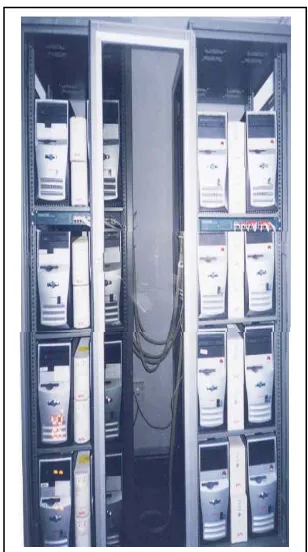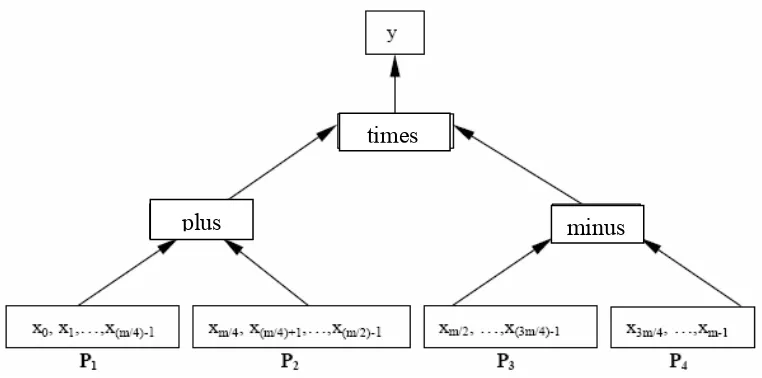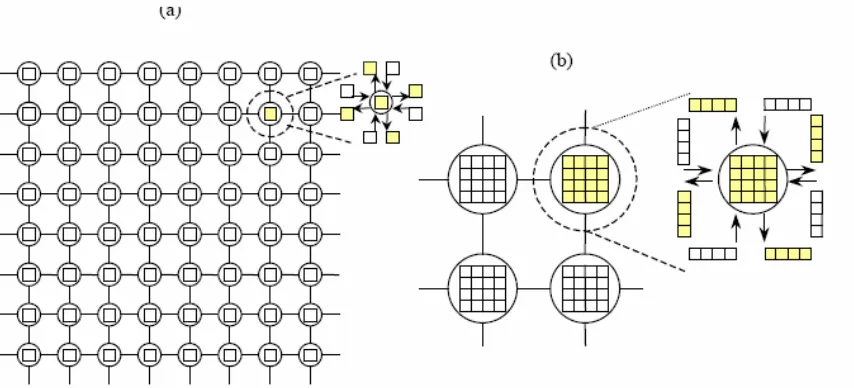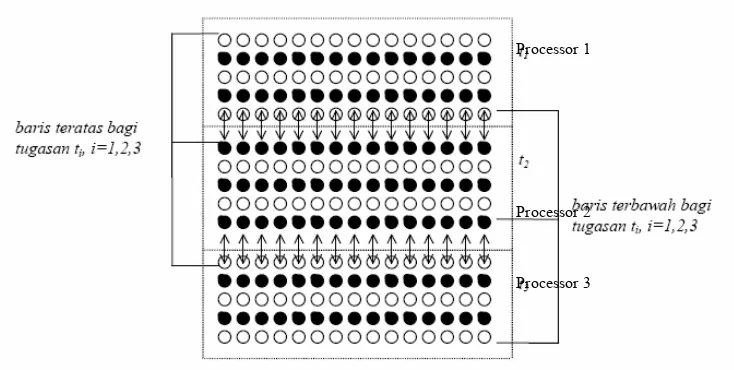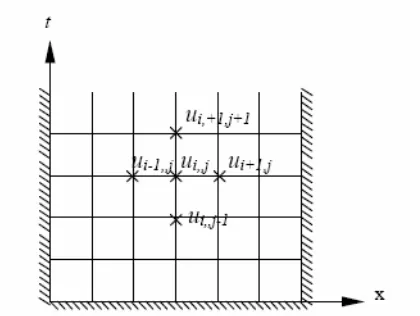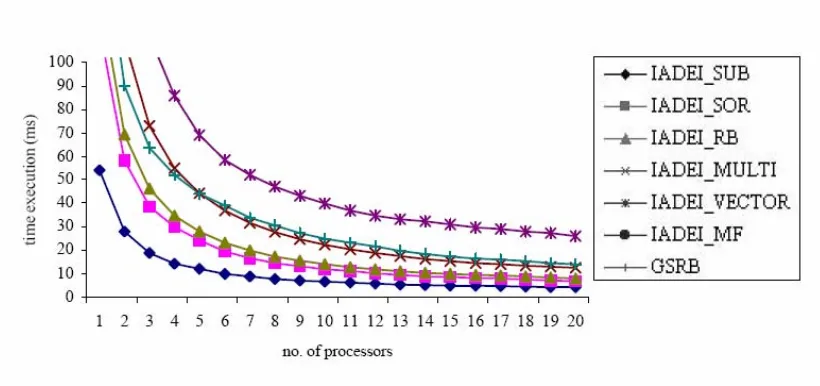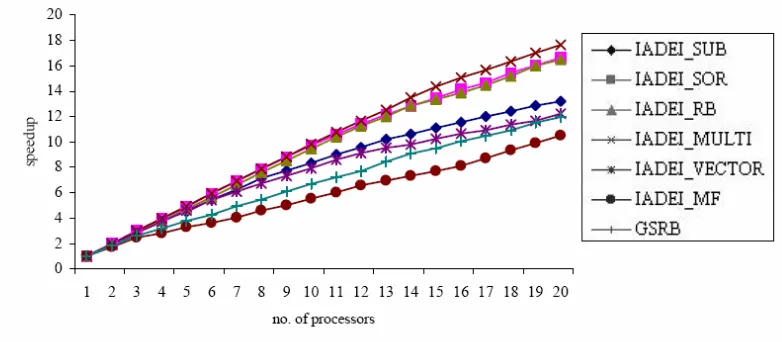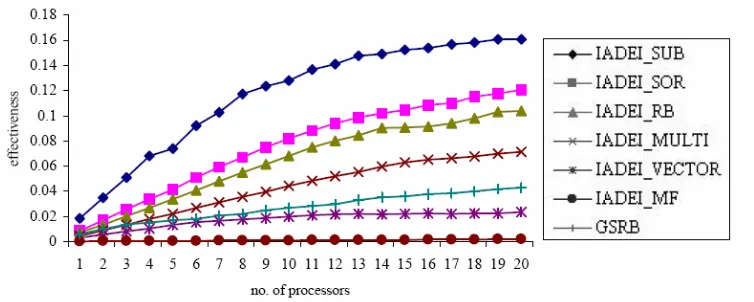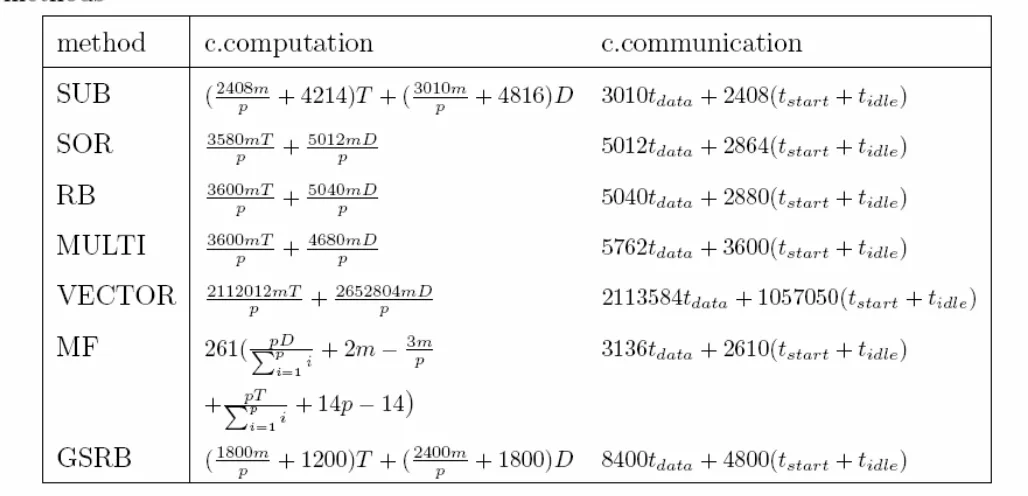UTM/RMC/F/0024 (1998) Lampiran 20
UNIVERSITI TEKNOLOGI MALAYSIA
BORANG PENGESAHAN LAPORAN AKHIR PENYELIDIKAN
TAJUK PROJEK : Parallel strategies on a distributed parallel computer system vot: 75019, Ketua projek: Dr. Norma Alias
Saya DR. NORMA ALIAS
(HURUF BESAR)
Mengaku membenarkan Laporan Akhir Penyelidikan ini disimpan di Perpustakaan Universiti Teknologi Malaysia dengan syarat-syarat kegunaan seperti berikut :
1. Laporan Akhir Penyelidikan ini adalah hakmilik Universiti Teknologi Malaysia.
2. Perpustakaan Universiti Teknologi Malaysia dibenarkan membuat salinan untuk tujuan rujukan sahaja.
3. Perpustakaan dibenarkan membuat penjualan salinan Laporan Akhir Penyelidikan ini bagi kategori TIDAK TERHAD.
4. * Sila tandakan ( / )
SULIT (Mengandungi maklumat yang berdarjah keselamatan atau Kepentingan Malaysia seperti yang termaktub di dalam
AKTA RAHSIA RASMI 1972).
TERHAD (Mengandungi maklumat TERHAD yang telah ditentukan oleh Organisasi/badan di mana penyelidikan dijalankan).
TIDAK
TERHAD
TANDATANGAN KETUA PENYELIDIK
Nama & Cop Ketua Penyelidik
CATATAN : * Jika Laporan Akhir Penyelidikan ini SULIT atau TERHAD, sila lampirkan surat daripada pihak
PARALLEL STRATEGIES ON A DIS
PARALLEL
COMPUTER
SYSTEM
PARALLEL STRATEGIES ON A DISTRIBUTED PARALLEL COMPUTER SYSTEM
(KAEDAH-KAEDAH SELARI PADA SISTEM KOMPUTER SELARI TERAGIH)
NORMA ALIAS
NORMA BINTI ALIAS
RESEARCH VOTE NO: 75019
JABATAN MATEMATIK
FAKULTI SAINS
Jabatan Matematik
Fakulti Sains
Universiti Teknologi Malaysia
ii
PENGHARGAAN
Setinggi-tinggi penghargaan ditujukan kepada Pusat Pengurusan Penyelidikan, RMC, UTM dan Jabatan Matematik Fakulti Sains UTM di atas kerjasama sepanjang penyelidikan ini dijalankan. Ucapan ribuan terima kasih kepada para penyelidik-penyelidik yang telah memberikan sumbangan secara langsung dan tidak langsung dalam menyiapkan kajian tersebut.
Hanya Allah S.W.T yang akan membalas jasa murni tersebut yang telah disumbangkan oleh semua pihak. Semuga penyelidikan ini mendapat keberkatan dan akan diteruskan pada masa akan dating dalam mencapai objektif secara global.
ABSTRACT
iv
ABSTRAK
CONTENTS
PAGE
Title i
Acknowledgement ii
Abstract iii
Abstrak iv
Contents v
List of Tables vii
List of Figures viii
List of Acronyms ix
Chapter 1 Introduction 1
1.1 High Performance Computing 1
1.2 Single Instruction, Multiple Data (SIMD) 2
1.2.1 General Characteristics 2
1.2.2 Advantages 3
1.2.3 Disadvantages 3
1.3 The development of a parallel computer program 5
1.3.1 Four steps 5
1.3.2 Processes of parallel programming 6
Chapter 2 Literature 7
2.1 IADE Methods 7
2.2 AGE Methods 7
2.3 Some Numerical methods 8
vi
3.1 Sequential algorithms 9
3.2 Parallel IADE algorithms 11
3.2.1 IADEI-SUB 11
3.2.2 IADEI-RB 12
3.2.3 IADEI-SOR 12
3.2.4 IADEI-MULTI 13
3.2.5 IADEI-VECTOR 14
3.2.6 IADEI-MICHELL-FAIRWEATHER 14
3.3 Parallel AGE algorithms 15
3.3.1 DOUGLAS Algorithms 15
3.3.2. BRIAN method 15
3.3.3 Gauss-Seidel method 16
3.4 Model Problems 18
3.4.1 One dimensional problem 18
3.4.2 Two dimensional problem 19
3.5 Parallel implementation 19
3.5.1 IADE Methods 19
3.5.2. AGE Methods 20
Chapter 4 Computational Results 21
4.1 Parallel performance measurement 21
4.2 IADE Methods 22
4.3 AGE Methods 27
Chapter 5 Concluding Remarks and suggestions 34 5.1 IADE Methods 34
5.2 AGE Methods 34
LIST OF TABLES
Table No. Title Page
1 Performance measurements of the parallel strategies of IADEI methods.
24
2 Computational complexity for iteration for the parallel strategies of the IADEI methods.
27
3 Performance measurements of the sequential BRIAN and DOUGLAS methods
30
4 Computational complexity for parallel BRIAN and DOUGLAS methods
31
5 Communication cost for parallel BRIAN and DOUGLAS methods
31
6 Execution, communication and idle times (μ sec) for parallel BRIAN and DOUGLAS methods
32
7 Computational / communication ratio for the parallel BRIAN and DOUGLAS methods
32
8 Performance measurements vs. number of processors for the parallel BRIAN and DOUGLAS methods
viii
LIST OF FIGURES
Figure no. Title Page
LIST OF ACRONYMS
Acronym
SIMD Single Instruction, Multiple Data NUMA Non-uniform Memory Access
IADE Iterative Alternating Decomposition Explicit
AGE Alternating Group Explicit
Chapter 1
Introduction
This research surveys new trends that will introduced a new approach in regards of solving a tridiagonal structure of matrices complex problems. This new loom will have a great major impact on all aspect of Mathematics and Science growth. It revealed under parallel computing technology in its evolution from chronological to parallel algorithmic practice. The exposure of iterative or domain decomposition approximate methods such as Jacobi and Gauss-Seidel Red Black, provides a consisted of guessing a value that initial guesses is to assume that they are all zero. Even some cases stated that Numerical method is useful; with some advantageous from Gauss Seidel Red Black’s exposure, it had been the best method chosen in solving the parallelization algorithm of PDE problems. The experiment of parallel computing were carried out in more that 2 PC Intel Pentium IV under homogenous architecture platform of LINUX to perform the algorithm. The comparisons between sequential and parallel algorithm will be presented. The result of some computational experiments and the parallel performance in solving the equations will be discussed.
1.1 High Performance Computing
There are different ways to classify parallel computers. One of the more widely used classifications, in use since 1966, is called Flynn's Taxonomy.
S I S D
Single Instruction, Single Data
S I M D
Single Instruction, Multiple Data
M I S D
Multiple Instruction, Single Data
M I M D
Multiple Instruction, Multiple Data
1.2 Single Instruction, Multiple Data (SIMD):
A type of parallel computer Single instruction: All processing units execute the same instruction at any given clock cycle multiple data: Each processing unit can operate on a different data element. This type of machine typically has an instruction dispatcher, a very high-bandwidth internal network, and a very large array of very small-capacity instruction units, Best suited for specialized problems characterized by a high degree of regularity, such as image processing. Synchronous (lockstep) and deterministic execution two varieties: Processor Arrays and Vector Pipelines
Examples (some extinct):
Processor Arrays: Connection Machine CM-2, Maspar MP-1, MP-2
Vector Pipelines: IBM 9000, Cray C90, Fujitsu VP, NEC SX-2, Hitachi S820 Distributed Memory
1.2.1 General Characteristics
3
Processors have their own local memory. Memory addresses in one processor do not map to another processor, so there is no concept of global address space across all processors. Because each processor has its own local memory, it operates independently. Changes it makes to its local memory have no effect on the memory of other processors. Hence, the concept of cache coherency does not apply.
When a processor needs access to data in another processor, it is usually the task of the programmer to explicitly define how and when data is communicated. Synchronization between tasks is likewise the programmer's responsibility.
The network "fabric" used for data transfer varies widely, though it can be as simple as Ethernet.
1.2.2 Advantages
Memory is scalable with number of processors. Increase the number of processors and the size of memory increases proportionately. Each processor can rapidly access its own memory without interference and without the overhead incurred with trying to maintain cache coherency. Cost effectiveness: can use commodity, off-the-shelf processors and networking.
1.2.3Disadvantages
According to Wikepedia, the free encyclopedia in Internet, the definitions of Parallel Computing is the simultaneous execution of the same task (split up and specially adapted) on multiple processors in order to obtain results faster. The idea is based on the fact that the process of solving a problem usually can be divided into smaller tasks, which may be carried out simultaneously with some coordination.
With the idea of 20 PCs, 20 GB Hard Disk (each), 1.67 MHz processors (each) and using Intel Pentium IV; to obtaining the fastest result in solving PDE can be resolved with this machine.
5
This research encompasses studies on recent advances in development of the parallel algorithmic techniques to solve a large-scale problems involving the solution of The Partial Differential Equations problems had been discussed with a few methods that are; the implementation of domain decomposition technique with introduces of [A] = [L] [U].
1.3 The development of a parallel computer program
There are a few steps to develop the parallel computer programs.
1.3.1 Four steps
There are 4 steps in developing a parallel program, which is done by student with understanding some important concepts such as task, process and processors
1. Decomposition 2. Assignment 3. Algometric 4. Mapping
Secondly, specifying mechanism to divide work among processes statically or dynamically assigned. The function of this part is to maximize work balancing, reduce communication activities and management cost.
Thirdly is structuring communication, organizing data and scheduling tasks. The goals are to reduce cost of communication and synchronization, schedule tasks to satisfy dependency and reduce overhead of parallelism management. Lastly, mapping the process into particular processors based on network topology.
1.3.2 Processes of parallel programming
The processes in creating a parallel program are as follows: 1. Assumption that the sequential algorithm is given. 2. Identify work that can be done in parallel
3. Partition work and data among processes
7
Chapter 2
Literature
2.1 IADE Methods
Six strategies of parallel algorithms are implemented to exploit the convergence of IA DE. In the domain decomposition strategy the IADE Michell-Fairweather which is fully explicit is derived to produce the approximation of grid-i and not totally dependent on the grid (i-1) and (i+1). In IADE Red Black and IADE SOR strategies, the domain is decomposed into two different subdomains. The concept of multidomain is observed in the IADE Multicoloring method. The decomposition of domain split into w different groups of domain. On the vector iteration strategy, parallel IADE is run in two sections. This method converges if the inner convergence criterion is achieved for each section.
2.2 AGE Methods
2.3 Some Numerical methods
9
Chapter 3
Methodology
minus plus
times
Figure 3.1: Domain decomposition technique for arithmetic operations.
Parallel strategies under consideration are focuses on domain decomposition technique as shown in figure above. The figure shows the examples of domain decomposition technique for arithmetic operations.
The new technique known as Iterative Alternating Decomposition Explicit Interpolation
11
3.2 Parallel IADE algorithms
The objectives of the parallel algorithms are to minimize the communication cost and computational complexity.
Figure 3.2: Minimizes the communication cost between the grids.
The sequential algorithm for IADEI shown that the approximation solution for grid ui is depend on ui-1 and the approximation solution for um+1-I is depend on um+2-i. To avoid dependently situation, some parallel strategies is developed to create the non-overlapping subdomains.
3.2.1 IADEI-SUB
3.2.2. IADEI-RB
In IADEI-RB strategy, the domain is decomposed into two different subdomains. There are the approximate solution on the odd grids and even grids. Computation on odd grids is executed followed by even grids. These two subdomains are not dependent on each other. IADEI-RB is run in parallel for each subdomain in alternating way on two time steps. The parallel IADEI-RB formula is as follows,
3.2.3. IADEI-SOR
13
3.2.4 IADEI-MULTI
Multicolor technique has been used extensively for the solution of the large-scale problems of linear system of equations on parallel and vector computer (Ortega, 1987). By the definition of multidomain, the domain is decomposed into w different groups. IADEI-MULTI is an advanced concept of IADEI-RB. Typically, one chooses the minimum number of colors w so that the coefficient matrix takes the block form. In particular w=2, then IADEI-MULTI is the IADEI-RB. The Domains for colors 1, 2, 3, ... , w are noted as w1, w2,..., ww . The subdomains wi are distributed into different groups of grid. In the process of assignment, subdomains wi are mapped into the processors p in the alternating way. At each time step, the computational grid for domain started its execution with w1, followed by w2 and ends with ww. The IADEI-MULTI allows the possibility of a high degree of parallelism and vectorization. However, IADEI-MULTI, as opposed to the natural ordering, may have a deleterious effect on the rate of convergence.
Processor 3 Processor 2 Processor 1
3.2.5 IADEI-VECTOR
On the vector iteration strategy, the parallel IADEI-VECTOR is run in two convergence sections. The first section is at time level (k+1/2) and the second section is time level (k+1). This method converges if the inner convergence criterion is achieved for each section. The inner convergence criterions are definite global convergence criterion.
3.2.6 IADEI-MICHELL-FAIRWEATHER
15
3.3 Parallel AGE algorithms
The parallel strategies is based on straighforward concept to minimizes the communication and computational costs.
3.3.1 DOUGLAS Algorithms
DOUGLAS Algorithms is based on the Douglas - Rachford formula for AGE fractional scheme (Sahimi, 1989) takes the form,
3.3.2. BRIAN method
3.3.3 Gauss-Seidel method
Gauss-Seidel method is chosen as a control schems. The Gauss-Seidel method is a technique used to solve a linear system of equations. The method is named after the German mathematicians Carl Friedrich Gauss and Philipp Ludwig von Seidel. The method is similar to the Jacobi method (and likewise diagonal dominance of the system is sufficient to ensure convergence, meaning the method will work).
We seek the solution to a set of linear equations, expressed in matrix terms as
The Gauss-Seidel iteration is
17
Note that the computation of uses only those elements of that have
already been computed and only those elements of that have yet to be advanced to iteration k + 1. This means that no additional storage is required, and the computation can
be done in place ( replaces ). While this might seem like a rather minor concern, for large systems it is unlikely that every iteration can be stored. Thus, unlike the Jacobi method, we do not have to do any vector copying should we wish to use only one storage vector. The iteration is generally continued until the changes made by an iteration are below some tolerance.
Algorithm
Chose an initial guess φ0
for k := 1 step 1 until convergence do for i := 1 step until n do
σ = 0
for j := 1 step until i-1 do
end (j-loop)
for j := i+1 step until n do
end (j-loop)
end (i-loop)
3.4 Model Problems
3.4.1 One dimensional problem
19
3.4.2 Two dimensional problem
The parallel strategies were tested also on the 2-dimesional parabolic partial differentials equation as follows (Gourlay & MacGuire, 1971),
3.5 Parallel implementation
3.5.1 IADE Methods
typical parallel implementation of a parallel IADEI assigns several mesh points to each processor p such that each processor only communicates with its two nearest neighbors. The computations of the approximation solutions in subdomain wp are executed independently. The stopping criteria in the processors p are investigated by measuring the size of the inner residuals. Let us define the residual computed in the processors p. This quantity is kept in the processor's memory between successive iterations and it is checked if the residual is reduced by the convergence criterion. The master processor checked the maximum of local convergence criterion and the iteration stopped when the global convergence criterion is met.
3.5.2. AGE Methods
21
Chapter 4
Computational Results
4.1 Parallel performance measurement
The following definitions are used to measure the parallel strategies, speedup 1
p p T S T = ,
efficiency p p
S C
P
= , effectiveness p p
p
C F
T
= , and temporal performance , where
is the execution time on one processor, is the execution time on p processors and
the unit of
1
p p
L =T−
1
T Tp
p
L is work done per microsecond. The important factors effecting the
performance in message passing on distributed memory computer systems are communication patterns and computational per communication ratios.
The important factors affecting the performance in message-passing paradigm on a distributed memory computer systems are communication patterns and computational/ communication ratios. The communication time will depend on many factors including network structure and network contention (Wolfgang, 1988). Parallel execution time,
tpara is composed of two parts, computation time (tcomp) and communication time (tcomm).
tcomp is the time to compute the arithmetic operations such as multiplication and addition
operations of sequential algorithms. Analysis of the tcomp assumes that all the processors
are the same and the operating at the same speed. tcomm will depend upon the size of
message. If the number of iterations b, and size of the message for communication m, the formula for communication time is as follows,
tcomm =b( tstart + m tdata + tidle )
where tstart is the startup time (message latency). tdata is time to send a message with no
data. The term tdata is the transmission time to send one data word. tidle is the time for
message latency; time to wait for all the processors to complete the process as shown in the figure below. It is also a means of quantifying the degree of load imbalance in the parallel algorithm. In order to estimate the coefficients tstart and tdata , a number of
Figure 4.1 : Idle time in communication process
4.2 IADE Methods
The results obtained for the various parallel strategies of IADEI in table below. The worst performances are shown by IADEI-MF and IADEI-VECTOR. The sequential IADEI is better in accuracy and convergence than all the parallel strategies of IADEI. In comparison with the parallel strategies of IADEI, these results also show that the time execution for IADEI-SUB was about 2 times shorter than other parallel strategies. Furthermore, IADEI-SUB is the best in terms of convergence and accuracy.
23
the increasing p. IADEI-SUB strategy is found to give the best performance because of the minimum memory access and data sharing.
At p=20 processors, all the parallel strategies of IADEI yield approximately equal performance in speedup. The efficiency of IADEI-MF and IADEI-VECTOR strategies are decreased drastically. This is the result of the additional overhead imposed by having communications routed though the PVM daemon with high number of iterations.
The results have shown that the effectiveness of SUB is superior to the IADEI-SOR, IADEI-RB and IADEI-MULTI for all numbers of processors. Usually, the temporal performance is used to compare the performance of different parallel algorithms. The temporal performance of the parallel strategies as in the following order,
25
Figure 4.3 : The speedup vs. number of processors
Figure 4.5 : The effectiveness vs. number of processors
27
4.3 AGE Methods
DOUGLAS and GSRB methods. The increasing of idle time is due to several factors such as network load, delay and load imbalance.
The reductions in execution time often becomes smaller when a large number of processors is used. A nice speedup can be obtained for all applications with 20 processors. The efficiency of the DOUGLAS method decreases Faster than BRIAN method. The BRIAN method is good in terms of effectiveness and the temporal performance where data decomposition is run asynchronously and concurrently at every time step with the limited communication cost. As the result, the BRIAN method allows inconsistencies due to load balancing when the extra computation cost is needed for boundary condition.
29
Figure 4.8 : The efficiency vs. number of processors
Table 3 : Performance measurements of the sequential BRIAN and DOUGLAS methods
31
DOUGLAS methods
33
Chapter 5
Concluding Remarks and Suggestions
5.1 IADE Methods
A new approach for study of the IADE method using linear interpolation concept. A method of this kind, namely IADEI was discussed in solving one dimensional parabolic partial equations. A comparison with the parallel strategies of IADEI scheme shows that the IADEI-SUB has extended range of efficiency, speedup and effectiveness. Furthermore, the superiority of the IADEI-SUB is also indicated by the highest value of the temporal performance, accuracy and convergence in solving large-scale linear algebraic equations on a distributed memory multiprocessors platform, which is superior for all numbers of processors. As the conclusions:
1. Some parallel strategies code for PDE problems has been successfully developed and validated.
2. The method of parallelization by both the method of IADE and IADEI parallelization using domain decomposition technique were successfully implemented into SIMD codes. 3. The convergence rates are found to be independent of number of partitions and iterations.
4. The sequential of IADEI method has lower speedups and poorer scalability than the parallel IADEI-SUB method, due to rapid rise in the time spent on communication as a result of denser coarse grids used.
5.2 AGE Methods
35
communication time. The result on a cluster of workstations shows that BRIAN method is a more efficient algorithm than DOUGLAS. BRIAN method is shown to be more accurate than the corresponding DOUGLAS scheme. Parallel BRIAN method is inherently explicit, the domain decomposition strategy is efficiently utilized, straightforward to implement on a cluster of workstations.
6. REFERENCES
http://en.wikipedia.org/wiki/Parallel%5Fcomputing Wednesday February 2, 2006
Alias, N., Sahimi, M.S., Abdullah, A.R., (2004). The development and Implementation of Efficient Parallel Strategies on a Cluster Sistem Using a Message-Passing Applications. Proceeding of 7 th International Conference On Work With Computing Sistems. 869-873.
Alias, N., Yan C. H. Arriffin A.K. & Sahimi, M.S., (2004). High Performance Computing for 2 Space Dimension Problems on PC Cluster Sistem. Proceeding of 7 th International Conference On Scientific And Engineering Computation. Singapore. CD Format.
Alias, N., Sahimi, M.S., Abdullah, A.R., (2004). PVM-based implementation of and ADI in solving one dimension parabolic Equation using PC Cluster Sistem. International Conference On Mathematics and Its Applications. ICMA, Kuwait University. Pg 5.
Alias, N., Sahimi, M.S., Abdullah, A.R., (2004). Communication issues for Parallel Alternating Group Explicit Methods on a Distributed Memory Architecture. 2nd International Conference On Artificial Intelligence in Engineering and Technology. Pg 840-844.
Chalmer, A. Tidmus, J. (1996). Practical Parallel Processing An Introduction to Problem Solving in Parallel. International Thomson Komputer Press.
37
Quinn, Michael J. (2004) Parallel Programming in C with MPI and OpenMP
